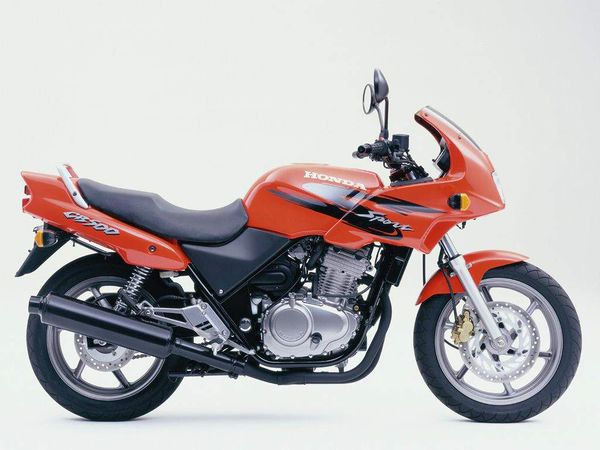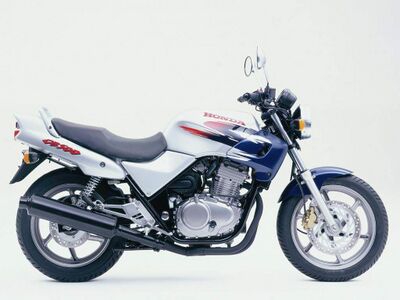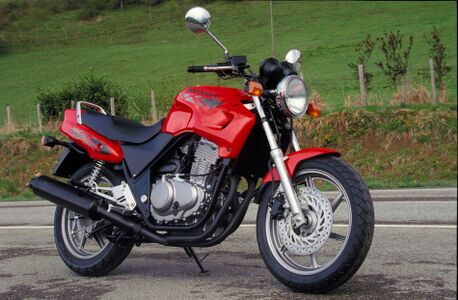Difference between revisions of "Honda CB500"
m |
m (→Photos) |
||
| Line 32: | Line 32: | ||
== Photos == | == Photos == | ||
| − | + | <gallery mode="packed" heights=200px> | |
| − | + | File:Honda CB 500E 98.jpg| | |
| − | + | File:CB500 AM94-AMB-040.jpg| | |
| − | + | </gallery> | |
| − | |||
| − | |||
{{Ads_feed}} | {{Ads_feed}} | ||
{{ads_post}} | {{ads_post}} | ||
Latest revision as of 13:17, 27 June 2023
The model of the classic road motorcycle Honda CB 500 dates back to 1994 and was produced until 2002 inclusive. The model was oriented only for export and was sold mainly in the market of European countries. Due to its reliability, simplicity and low cost, the motorcycle was widely used in courier services. Despite the small volume, the Honda CB 500 had sufficient dynamic characteristics, and the engine resource, according to Honda engineers, was 300,000 km.
The main competitors:
The Honda CB 500 was based on an in-line 2-cylinder liquid-cooled engine with a volume of about 500 cc. see, issuing 57 hp. power and 47 Nm of torque. The maximum speed of the motorcycle was, according to various sources, from 185 to 193 km / h.
The motorcycle is also distinguished by simple equipment: a classic steel tubular frame, disc brakes (rear drum brake until 1997), suspension in the form of a conventional telescopic fork and double shock absorber, narrow 17-inch wheels, an 18-liter fuel tank and from 170 kg dry weight.
The main modifications of the Honda CB 500:
- Honda CB500 - regular classic version.
- Honda CB500S - "sports" version. It features a front fairing with a rectangular headlight and the "Sport" lettering on the side plastic. It has been available since 1998.
2002 was the last year of production for the Honda CB 500, after which it was discontinued. The main reason for this was the update of the environmental emission standards to Euro-2, which the motorcycle no longer met. As a successor, an updated model Honda CBF500 was introduced, which received more modern features and equipment, but in fact had the same engine.
Reincarnation of the CB 500 Series
Since 2013, under this name, a series of motorcycles has been produced, manufactured in Thailand and focused on the Asian market:
- Honda CBR500R - sports version (sold in Russia).
- Honda CB500F - naked version.
- Honda CB500X - Touring Enduro version.
All three motorcycle models are based on the same platform and engine, and have nothing to do with the European model Honda CB 500 (1994-2002) described in this article.
Photos
Specifications
Specifications Honda CB 500 and Honda CB 500 S:
| Model | Honda CB500 |
|---|---|
| Motorcycle type | road (classic) |
| Release year | 1994-2002 |
| Frame | steel duplex |
| Engine type | 2-cylinder, 4-stroke, in-line |
| Working volume | 499 cc cm. |
| Bore / stroke | 73.0mm x 59.5mm |
| Compression ratio | 10.5: 1 |
| Cooling | liquid |
| Number of valves per cylinder | DOHC, 4 valves per cylinder |
| Fuel supply system | carburetor, 2x Keihin VP 34 mm |
| Ignition type | electronic (CDI) |
| Maximum power | 57 hp (42.5 kW) at 9500 rpm |
| Maximum torque | 47 Nm (4.8 kgm) at 8000 rpm |
| Gearbox | 6-speed |
| Drive type | chain |
| Front tire size | 110 / 80-17 57H |
| Rear tire size | 130 / 80-17 65H |
| Front brakes | 1 disc 296mm, Nissin 2-piston caliper - CB500R, CB500T
1 disc 296 mm, 2-piston Brembo caliper - CB500V / W / X / Y, CB500S |
| Rear brakes | 160mm drum - CB500R, CB500T
1 disc 240 mm, 1-piston caliper - CB500V / W / X / Y, CB500S |
| Front suspension | 37mm Telescopic Fork (Fixed), 115mm Travel |
| Rear suspension | Dual Shock Absorber (5-Stage Preload Adjustment), 117mm Travel |
| Length | 2090 mm |
| Width | 720 mm |
| Height | 1050 mm (1160 mm - CB500S) |
| Wheelbase | 1430 mm (1435 mm - CB500S) |
| Saddle height | 775 mm |
| Acceleration to 100 km / h | 4.3 sec |
| Maximum speed | 185-193 km / h |
| Fuel tank capacity | 18 l (including reserve - 2.5 l) |
| Motorcycle weight (dry) | 170 kg - CB500R, CB500T
173 kg - CB500V / W / X / Y 179 kg - CB500S |
Fuel consumption
The average fuel consumption for the Honda CB 500, according to the owners, is 5-6 liters per 100 kilometers. The exact value depends on the riding style.
Documentation


